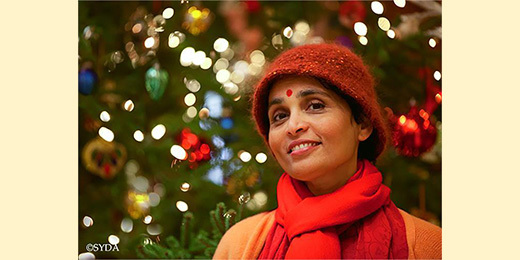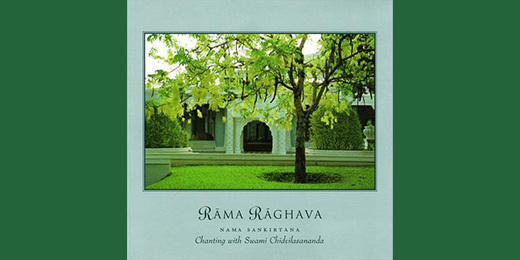


Throughout this month, I have taken great pleasure in revisiting this “Season’s Greetings 2025” gift from Gurumayi. The sweet bird coming out of its box, singing in an assertive voice, makes me laugh every time. It brings me an irresistible and wonderful explosion of joy.
I am also fascinated by the sacred fire—which symbolizes the Heart for me—and even more so by its reflection on the floor, which looks like a river of light sending its blessings upon the earth. When I watch and experience the passage of time, the dancing stars, the meeting between the sun and the moon—indeed the whole universe of this gift, which is filled with my Guru’s love—I feel soothed and immersed in a wonderful state of calm and gratitude.
I am so moved by Gurumayi’s caring presence in my daily life.
Quebec, Canada
I am so grateful to Gurumayi for the most beautiful, most precious Christmas gift I have ever received. It is so divine—my words cannot describe the sense of calm joy that pervades my being as I watch it.
California, United States
I have watched Gurumayi’s “Season’s Greetings 2025” many times and each time I experience my heart becoming immersed in a cozy blanket of divine love, bliss, and contentment.
This latest time I noticed the AUM-shaped cloud surrounding the silvery-white moon. Also, I could almost feel the heat of the fireplace kissing my cheek. Simultaneously, I experienced the fire blazing away in my heart, immersing me in the words from Shrimad Bhagavad Gita, “I am the pure fragrance in the earth.” This led me to hear inwardly “I am, I am, I am. So’ham.”
St. Laurent, Canada
My favorite part of Gurumayi’s “Season’s Greetings” is when the star is going all the way around the sky, and then there is another spark that goes from outside the star and to inside the star!
I think that the middle of the star looks like the Blue Pearl if you look closely. Another part that makes me happy is when the little bird comes out of the golden box. And the bird’s tweeting noise makes me want to sing!
an eight-year-old from New York, United States
I loved the simplicity yet profundity of Gurumayi’s “Season’s Greetings 2025.” From the beautiful, swirling colors in the night sky at the beginning to the rising sun and bright moon at the end, I was drawn into a state of deep stillness and warmth in my heart as my mind was embraced and melted into silence.
To me, the music added depth to each changing scene and tied everything together beautifully. I felt the chirping of the sweet little bird beckoning me to wake up. Then the brightness and crackling of the fire immediately warmed my heart and calmed my mind. The framed teaching brought alive for me the sense of purity and oneness with all that is. The clocks on the trees reminded me to be present and relish each precious moment.
I’m deeply grateful for my experience of Gurumayi’s exquisite and profound gift.
New Jersey, United States
When I saw the sublime “Season’s Greetings 2025” from Gurumayi, I noticed the sacred symbol Om and the golden heart on the tops of the Christmas trees. As I was watching them, I reflected on Om as the infinite and on the golden heart as love, and I connected them to Bade Baba’s name, Nityananda, which means “eternal bliss.” At that moment I felt a very strong and stable connection with the Guru within.
At the end of the video, I was captivated by the little point of light that follows the big, luminous golden star and merges into it.
Such a wonder, such a blessing! I feel happy and grateful to my beloved Gurumayi.
Milan, Italy
“Season’s Greetings 2025” from Gurumayi fills my soul with joy, spaciousness, and awe. The images, symbols, and mellifluous musical accompaniment feel like an invitation to embrace the divine “play of Consciousness.” Each image and symbol offer me gentle guidance on how to release 2025 with grace and to open my heart to the possibilities of 2026.
The columns framing the Christmas scene remind me to remain ever in the Temple and to stay steadfast in the awareness of the Self. The heart crowning one Christmas tree invites me to dwell continually in the Heart.
When I read the luminous quote from the Bhagavad Gita, a renewed commitment arises within me to remain joyful, no matter the circumstances of my internal or external landscape.
As I reflect on “the austerity in sages and seekers,” I realize that the austerity most needed in my life is to hold fast to Gurumayi’s love and inhale it into every part of my being. I offer my gratitude for her boundless blessings by committing to my sadhana completely.
Sydney, Australia
In this video I experienced the gifts of subtle sights and sounds that I often take for granted. I was particularly moved by the sounds of the crackling fire and the song of the tiny bird. I also loved the soft array of magnificent colors that depicts the outside light at different times of day. The majesty of the sunrise and the exquisite colors around the moon touched my heart.
All of these experiences reminded me once again to be present in each moment so as to behold the splendor of this blessed life I have been given.
New York, United States
As I look at the beautiful images in Gurumayi’s “Season´s Greetings 2025”—the fireplace, the decorations, the Christmas trees, the Om symbol and the heart at the top of the two trees, the star, and the beautifully framed teaching—the thought “My home, my home” arises in my mind, and with it, I feel a deep connection to my own home. It is beautiful to feel this unity!
The clocks, in particular, catch my attention, awakening in me a new experience of Gurumayi’s Message for 2025, “Make your time worth your time.” Seeing the clocks on the Christmas trees inspired me to decorate the clocks in my house for Christmas, adding even more beauty to the holiday decorations already there.
I believe that my beloved Gurumayi has always touched everything in my life with her grace. My experience of “home” is continually renewed as I follow her teachings and develop my sadhana.
My heart is filled with gratitude for such a beautiful gift.
Mexico City, Mexico
I am very grateful to Gurumayi for this splendid holiday video. I have also appreciated the shares from Siddha Yoga students, which have embellished my understanding of the video’s many exquisite details. As I sit in front of the fireplace in the video on this cold and snowy day, my experience of the video seems comparable to the journey to the Self, as the Blue Pearl ultimately reflects the sun and the full moon and the verse from the Bhagavad Gita.
Vermont, United States
My first experience upon viewing this exquisite gift of Gurumayi’s “Season’s Greetings 2025”was to feel deeply moved by the music and, equally, by the teaching from Shrimad Bhagavad Gita.
Each time I view this gift, I discover something new to delight in. Most recently, the golden hummingbird ornament caught my attention and touched my heart.
The image of a sweet hummingbird has been with me all year in the form of Gurumayi’s Message Artwork. One morning this past summer, I opened my porch door, and just then a hummingbird flew quickly toward me, nearly touching me in the region of my heart. Then today, I discovered that the wings of hummingbirds move in a figure eight, like the infinity sign.
I am noticing that every image and sound in “Season’s Greetings 2025” contains a subtle (and sometimes not-so-subtle) meaning which directs me lovingly toward Gurumayi’s Message for 2025.
New York, United States
I absolutely love this beautiful “Seasons Greetings.” The little twittering bird and the clocks in the trees seem to be telling me to walk up—it’s still not too late to practice Gurumayi’s Message for 2025! Such a sweet reflection of the Message—a loving reminder that now is the perfect time to refresh my intention and “make my time worth my time.”
New Delhi, India
“Season’s Greetings 2025” from Gurumayi has felt like an invitation for me to pause, breathe, and reconnect with myself and with my Guru. I experience an immense sense of peace as I gaze at the images and listen to the sounds of the piano, whose notes move in perfect harmony with everything unfolding on the screen.
As the music plays, a stillness gently fills the atmosphere, even though there is a delicate dance of movement onscreen. The melody touches my heart, and the little bird’s soft chirping brings a smile to my face and fills my being with joy.
Each time I watch, I find myself discovering new details with the wonder of a child. It fills me with love, sweetness, and strength. I feel like I am in the presence of my Guru. I will continue to revisit this precious gift, to imbibe its blessings, and to dive into the experiences it inspires with my whole heart. I cannot wait to watch it on Christmas Day with my family in our living room.
Valdemorillo, Spain
I’m so happy to be able to watch and listen to this wonderful video of “Season’s Greetings 2025” over and over again. Each time I do so, I discover something different and meaningful to me. The sounds in the video echo inside and outside of me, so powerful and sweet at the same time.
Today, when I once again watched the video, I focused on the image of the spark chasing the star and then merging into it. I found myself smiling at how much it reminded me of the Guru-disciple relationship. In addition, being able to read Gurumayi’s words in my own language made me melt with tenderness.
San Giorgio a Cremano, Italy
I experienced so many impressions watching this exquisite “Season’s Greetings 2025,” Shri Gurumayi’s gift to us all.
As the video starts, I feel as though the divine music makes the galaxies move and makes the angels—in the form of the aurora borealis—dance. The little bird, for me, is like the primordial Om, bringing creation into manifestation, making everything come alive and sparkle. The sparkles explode into the cozy Christmas scene, which reveals how transparent the walls of my reality are. This gives me the understanding that the grandeur of the universe caresses the apparently solid boundaries of my existence, if I only pay attention. Sun and moon, day and night, hour after hour on the face of the clock, the divine is always present, the light is always with me.
Just like the little sparkle, may I never give up the joyful chase of the supreme light! Indeed, I feel as though I am embraced and held with so much love.
Nelson, Canada
There are so many amazing details in this “Season’s Greetings” from Gurumayi. For me, they are playful and fun and carry important messages and teachings.
The clocks stood out for me—all of them showing different times. For me, the four clocks under the trees represent the gifts of the present; the four reflections of those clocks on the floor are the gifts of the past; and the two clocks hanging in the trees signify the gifts of the future.
The Om-shaped cloud around the full moon represents, for me, the steadfast, grounding anchor of the mantra that soothes my heart amid the changing and fleeting nature of time.
I am so grateful to Gurumayi for the joyfulness of this creation, and I look forward to observing it further and uncovering more connections to the heart.
Farnborough, United Kingdom
When I watched Gurumayi’s “Season’s Greetings 2025,” I saw clocks on the floor and in the fir trees. For me, they represented the different places in the world where we are celebrating this season. We are in different countries and different time zones, and yet our hearts are united.
Neuvic, France
After watching “Season’s Greetings 2025,” I felt as though the sacred flames of tapas, the fire of yoga, were awakening within me. A deep inner stillness arose, and in that stillness, I perceived myself as the Blue Pearl—radiant, infinite, and one with the vast universe. It was as if a gentle divine bird within me began singing the eternal glory of Shri Guru.
When I saw the fire, an inner wave of devotion naturally arose, and my heart bowed to the holy sandals of Shri Guru, the very source that imparts the supreme knowledge of Brahman. In that moment, I felt the Guru’s presence in the form of the sacred sacrificial fire, as the offerings made to the fire, as the priest who performs the ritual, and as the yajna, the fire ceremony, itself. Everything appeared as one continuous expression of the Guru’s grace.
This experience felt complete, pure, and non-dual, like an inner recognition that all forms, all rituals, all flames, and all beings are manifestations of the same eternal Brahman revealed through the Guru’s compassion.
Pune West, India
I am grateful for this beautiful holiday gift from Gurumayi and am enchanted by its glorious images and delightful music. I initially noticed the tiny Blue Pearl in the center of the gold star above the fireplace. Later, as the gold star danced through the heavens, there was a small white, sparkling light devotedly following it before merging into it. It reminds me of my own self following the Guru’s teachings and greatly desiring to merge into the Self, into the Blue Pearl.
Washington, United States
In my third viewing of Gurumayi’s “Season’s Greetings” video I decided to simply let the unseen grace flow into me and swirl about. Spontaneously my hands opened up to the heavens and effortlessly stayed there as a magical sweetness enveloped me and entered me. I knew that Gurumayi was offering me everything, as she always does, and that I could receive it by staying open and in simple exultation. Near the end of the video a delicate prayer formed within me: that I may be able to spread this love she has so beautifully granted me.
I am filled with gratitude.
Washington, United States
I am very appreciative of Gurumayi’s gift “Season’s Greetings 2025.” As I view and reflect on this sacred work of art, I am led to new discoveries in my sadhana.
The awe and connection I felt when I read “I am the austerity in sages and seekers” affect my mind and heart. The heat of austerities becomes as inviting as the warm crackling fire in the video. The austerities of meditation, chanting, and thinking good thoughts become so inviting.
As I see the spark from the fire dancing and joining the brilliant star, I set an intention to—through my practices and love—dance and become one with my Guru’s sacred light.
North Carolina, United States
I see the different clocks as being like precious presents under the tree. The fact that they are showing different times reminds me of how individual we are in using or offering our time.
As time goes by in the video, the wall opens to a beautiful sky, which keeps expanding into the universe. Similarly, when I meditate and connect with the heart, inside and outside become one.
I am grateful to Gurumayi for this gift.
Jona, Switzerland
A few mornings ago, as I was settling in to meditate, I felt an unexpected pull to open the Siddha Yoga path website—and there was Gurumayi’s “Season’s Greetings!”
Listening to and watching the magic unfold, I felt I was beholding the beauty of God and seeing this world through Gurumayi’s eyes and heart. Every element sparkled with beauty, meaning, intention, and playfulness! The infinite, star-filled sky decorated with the northern lights; the adorable little bird; the beautiful hall adorned in all its radiant splendor.
Watching nature paint endless masterpieces while composing her sweet sounds to accompany the piano, whose music seemed to dance perfectly with each image, was so deeply fulfilling!
When I read the quote from the Bhagavad Gita on the mantelpiece, I realized that the words heart and earth make up the word hearth! In that moment, everything seemed to connect including how nature reflects God’s power in all its glory and how incredibly fortunate I am to be a piece of thread within this glorious fabric of existence.
New York, United States
At Shree Muktananda Ashram, it is part of the Ashram Daily Schedule to recite several chapters of the Bhagavad Gita two mornings each week. After receiving this amazing gift of “Season’s Greetings” from Gurumayi, I was reciting the Bhagavad Gita and I noticed with elation that the verse from “Season’s Greetings” was in this week’s recitation!
When I recite the Bhagavad Gita, I experience that I am able to receive its immensely profound meaning on a deeper level. It stood out to me that, in sharing where the Self is found, Shri Krishna lists “the austerity in sages and seekers” together with “the pure fragrance in the earth,” “the brilliance in the fire,” and “the life force in all beings.” I began to consider how my own austerity in reciting scriptural texts is a form of this brilliance, this life-giving force. It made me excited about—and gave a new dimension and propulsion to—sadhana, as I look forward to a new year of life during this blessed holiday season.
a staff member at Shree Muktananda Ashram
The first time I watched the exquisite “Season’s Greetings 2025” from Gurumayi, I immediately felt my breath releasing, and I became aware of all the tension I’d been holding in my body and mind, due to feelings of anxiety about an upcoming event.
As I engaged with each scene in the video—its visual and auditory elements—I felt myself becoming more and more present. I also observed that I was feeling calm and content.
I returned to the video again during the event. This time, I had a strong experience of the Witness, the one who was watching all the changes happening in time—the rising and setting of the sun and moon, the shifts in weather and nature—yet remaining unaffected by it all.
I understood that just as “the brilliance in the fire” is unaltered, the Witness, the Self, remains unchanged and is beyond the limitations of time. I felt a deep sense of peace. I was able to return to this experience in the days that followed.
Coburg, Australia
When the image of the deep sky and stars first came into my vision, it reminded me of the beautiful dance of this planet. I smiled as I reflected on how that dance can both conceal and reveal the depth and beauty of the universal Consciousness that underlies everything. Then, when I read the teaching from the Bhagavad Gita, I experienced more stillness. The mantra So’ham, “I am That,” began to resonate inside me, reminding me that I am not different from That.
My experience of “Season’s Greetings” reminds me that I can enjoy the outer manifestations of Consciousness and the deep stillness that lies—always!—beneath. For this recognition, for the mantra, for Gurumayi’s teachings, gratitude fills my heart.
California, United States
After watching the video of Gurumayi’s “Season’s Greetings 2025,” I am left with a feeling of delight, anchored in beauty and peacefulness. What an exquisite dance of the aurora borealis, which seems to be extolling the mystery of life. I loved the little bird coming out of its shelter to share its beautiful birdsong with the universe. To me the music box represents the shelter of the Guru’s grace. It evokes the protection and knowledge I receive from the Siddha Yoga teachings and practices, as well as the recognition of the importance of taking refuge within. It also reminded me to come out and share joy and love.
I enjoyed being invited into this “Season’s Greetings” space with no walls, where I experienced the movement of time. I imagined everyone in the global Siddha Yoga sangham being in this place at different times of the day and night—partaking of its warmth, beauty, and peacefulness.
Sydney, Australia
The exquisite music accompanying the video of Gurumayi’s “Season’s Greetings 2025” captured my heart from the very first notes. I was extremely moved, as I seemed to merge with the sounds, and I felt the certainty of hope. I am so grateful.
New York, United States
My experience of Gurumayi’s warm, loving embrace in “Season’s Greetings 2025” led me to the coziness of my own heart. I saw the burning fire as the fire of love, the eternal fire of grace, burning away all my doubts, my sense of smallness, and anything that keeps me from experiencing Gurumayi’s pure love. This gave me the conviction that no matter when and how seasons of life change, or time changes from the light of day to the darkness of night, Gurumayi’s love is always present.
The verse from the Bhagavad Gita conveyed to me that my Shri Guru is ever present as my own inner Self. She is love, and I am the same love. There is no moment of time when she is not with me. Yes, Gurumayi and I are one; how divine this feels!
It seems a special blessing that Gurumayi gave us this teaching on December 1, which this year is Gita Jayanti, the day when it is said that Lord Krishna imparted the teachings of the Bhagavad Gita to his disciple, Arjuna.
a Gurukula student in Gurudev Siddha Peeth
Every time I viewed “Season’s Greetings 2025” by Gurumayi ji, it brought a tingling feeling to my heart and a smile to my face! I felt that my Guru had remembered me, and is sending her love to me. I loved the singing of the bird, who seemed to be saying, “Come and let’s celebrate God!”
As the comet followed the golden star near the end, I felt they were having fun, playing together, and merging into each other—like my Guru and me!
Pune, India
Gurumayi’s “Season’s Greetings 2025” took me to a place of such ease. Watching the beautiful video, I felt protected, serene, and joyful.
I also had an insight that day-to-day moments, such as quietly sitting by a fireplace, can lead to the experience of freedom and harmony with the world and universe I live in. I can enter the experience of timelessness as I absorb myself in a peaceful moment in time.
New York, United States
My heart is overflowing with love for this gift from my dear Guru. As I watched the small star playfully following the larger star, my heart was brimming with gratitude for all the gifts that I’ve received on the Siddha Yoga path.
As I commit to discipline in my sadhana, to kindness, and to caring for the world around me, I’m learning to walk in the way my precious Guru exemplifies. Like the two dancing stars in this “Season’s Greetings” video, I’m learning to dance in the light my Guru leads me to.
Pennsylvania, United States
I loved Gurumayi’s enchanting “Season’s Greetings 2025”! I felt Gurumayi’s love, her joyfulness, and her wonderful sense of humor shining through the colors and images and music. It felt like she was taking me through the dance of my life as I seek the experience of the Self, bringing me to the final merging at the end. It was profound and loving, full of rasa and potent with grace!
Vancouver, Canada
My entire being felt so calm and peaceful as I watched this beautiful “Season’s Greetings” from Gurumayi. The crackling of the fire and the chirping of the bird felt like nature’s contribution to the music. Seeing the rising sun and the moon in the sky was like seeing the beauty of God’s creation again and again, each time with greater awareness.
Indore, India
The festive lights everywhere remind me of the wondrous way I celebrate Christmas with Baba and Gurumayi—as the true celebration of the love, joy, and beauty of the human spirit. I am filled with gratitude for the Siddha Masters in my life.
Guadalajara, Mexico
Gurumayi’s “Season’s Greetings” is a true gift! I could watch it ten times a day; it is so simple, yet so deep. It instantly makes me present and grateful.
Mexico City, Mexico
As the fire crackled softly, my nine-year-old boys told me that they felt close to Gurumayi’s love. One said that he felt embraced in a cocoon of warmth from the fire’s glow. He was inhaling and getting so relaxed while imagining what time of the day the light reflection was. My other boy was finding surprises in the ornaments: an AUM and a hummingbird. They kept saying how magical it was. One of them was in awe and just so relaxed by the sound of the fire, while the other gazed upward, captivated by the sun, moon, and galaxies. Each moment was like a sweet and serene journey, a gentle reminder of calmness and joy.
I am grateful for this beautiful experience my children and I had of experiencing Gurumayi’s love.
Mexico City, Mexico
It touches my heart to know that Gurumayi has created such a beautiful “Season’s Greetings” video for people of all ages. The sound of the burning fire fills my whole being with warmth and a sense of safety. I know that there is much to learn and understand from this verse of the Bhagavad Gita, and I look forward to exploring the meaning of austerity in the days to come.
Thane West, India
I am so very grateful for this magical, mysterious, warm, and stupendous “Season’s Greetings” video from Gurumayi. Each note of music felt as brilliant as the stars in the sky. I loved the depiction of the Christmas trees, one topped with AUM and the other with a heart.
When I came to the end of this video, the words “I love myself” arose within me.
I am so thankful to Gurumayi for giving us her teachings in ever-fresh ways to awaken our hearts.
Virginia, United States
This beautiful video reminds me that the purpose of every moment of life is to experience the Self. Watching “Season’s Greetings” plunges me into the intimacy of my heart. As I listen to the classical music, admire the aurora borealis, hear the bird sing, savor the radiance of the fire, and take the time to contemplate the moon and the sun—I enter into happiness. As the external sights and sounds that connect me to happiness slowly fade, I continue to rejoice in a heart that delights in itself.
Going directly to my heart to find the essence of happiness is, for me, a foundational way I practice austerity. In the hearth of my meditation, the mantra and the breath connect me to an inner fire that shines with its own light.
Rodez, France
I became immersed in watching the fire and listening to its crackling and the accompanying music. I didn’t even realize time was going by. I found myself becoming relaxed and indrawn. I felt I was taking refuge in an inner sense of comfort and repose—a gift of “Season’s Greetings” from Gurumayi. It was exactly what I needed. I plan to return often to bask in this warming, soothing, grace-bestowing fire.
California, United States
After my morning meditation, I opened the Siddha Yoga path website, as is my habit. What a beautiful gift—“Season’s Greetings” from Gurumayi!
As soon as the video began, I felt a deep stillness embrace me. As the video continued, I felt Gurumayi’s grace and protection; gratitude for this beautiful path welled up from my heart and overflowed. Truly, I am blessed.
Puerto Vallarta, Mexico
Wow! I was hypnotized by the tenderness of this “Season’s Greetings” video from Gurumayi. Every detail is so exact and brought my focus inward to the space of the heart. I experienced a sense of peace as well as anticipation for new beginnings. I’m so thankful for the gentle care that was poured into this video.
Rome, Italy
This is the most beautiful Christmas scene I have ever seen! I felt the warmth from the fire in my heart and in my whole being. To me, the fire was Gurumayi’s love and compassion burning away my doubts and fears.
I am thankful to my beloved Gurumayi for her beautiful “Season’s Greetings.”
Washington, United States
I love this beautiful video. The interplay of colors and motifs quickly led me to my own essence, to my inner peace and contentment. How comforting it is for me to know that God’s love—the love of the Guru—is always there permeating everything, and I can always experience it when I find my own inner peace!
As I embrace the playful lightness and joy in this video, I am inspired to approach the upcoming festive season with similar lightness and joy.
Konolfingen, Switzerland
For me, Gurumayi’s “Season’s Greetings 2025” is a joyful summation of the teachings I have received from her Message for 2025.
From the opening moment in the light-filled universe, the images took me on a journey through time—sunrise, sunset, light, dark, day, night. The ever-changing images were reflected in the mercurial piano music, which moved between the contemplative opening theme to dynamic, swiftly moving passages. At the unperturbed heart of all this ebb and flow was the statement by Lord Krishna from the Bhagavad Gita, which I understood to be about the nature of the true Self, beyond the fluctuations of time.
By the end of my journey, as the luminous full moon dissolved and the music merged into silence, I was in a state of utter stillness. I cherish and treasure this profound gift from Shri Gurumayi, and will return to it again and again.
Georgia, United States
This “Season’s Greetings” video from Gurumayi is so beautiful! The majestic piano music feels like it is awakening my soul and telling me, “Wake up to the dance of life!”
I love the small clocks decorating the bottom of the two Christmas trees; they bring my awareness to Gurumayi’s Message for 2025 and remind me to honor my time and use it well. I also see the clocks as a sweet gesture of bidding farewell to this year and beginning to usher in the one coming in. And I especially love that each clock is set at a different time—a reminder to me that there is time to work, time to rest, time to give thanks, and time to read a book or dance. So many possibilities, so many roads, and they can all lead me to the experience of the Self.
Oh, how I love this incredible video!
California, United States
I was absolutely enthralled with the video of “Season’s Greetings,” with the warm and cozy fireplace and beautiful Christmas trees. The indigo-blue, starlit sky was enchantingly beautiful, as was the adorable bird dancing atop the blue music box.
It reminded me of the cozy haven I dive into during my meditations—the cozy haven of the Heart!
St. Laurent, Canada
Recently my family and I had the opportunity to spend time in nature. We marveled at the vastness and splendor of Mother Nature and observed the beneficial effect on our state. We always experienced sublime silence and inner stillness.
Now, as I receive the mahaprasad of “Season’s Greetings 2025” from Shri Gurumayi, I experience deep gratitude and love. It gives me an experience like the one I have when I am in nature, which leads me to my heart, the Blue Pearl, and the pure sound of OM.
I am very grateful to Gurumayi ji for her vision, through which she teaches us and showers her blessings upon humanity.
Thane, India
I am very thankful for this beautiful video, “Season’s Greetings 2025.” It is perfect and filled with Gurumayi’s love throughout. Everything warmed my heart, from the tiny bird chirping at the beginning to the magical fireplace with the splendid Christmas trees and wreaths, from the views of the heavens with the sun, moon, and stars to the music itself.
New York, United States
I am so grateful for this beautiful “Season’s Greetings” from Gurumayi. My heart feels so full. I love spending my time in this way, watching this beautiful video.
Melbourne, Australia




















